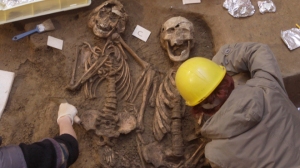New discoveries are being found daily, so let’s see what’s been happening this week in the world of archaeology and new findings.
- Ancient British farmers preferred dairy
Deposits found on the pots of ancient British farmers dating from 4,600 BC to AD 1,400 shows that the farmers changed their eating habits from wild foods to more “homely” cuisine. The hunter-gatherer used to eat wild animals like venison, seafood and wild boar, but with the introduction of farming and pastorialism, the ancient British changed to producing milk and eating the animals that make it.
The team excavating in Bristol found millions of potsherds and bones, analysing thousands of cooking pots to reveal this dietary change.
- Mammoth tusk found in Seattle
During construction work in Seattle, a building team came across a startling discovery – a mammoth tusk dating back to at least 16,000 years. Due to the laws concerning this type of thing, the landowner had the final decision whether or not they wanted it to be further investigated.
Fortunately the landowner has agreed to let the museum excavate further, which is awesome cause apparently this is one of the most intact tusks found in the area. Excited to see what else they dig up!
- Egyptian sarcophagus found at Luxor
A new tomb has been discovered in the Egyptian region of Luxor by a team of Spanish archaeologists. The sarcophagus dates back to 1600 BC, probably to the 17 Dynasty. The wooden coffin is decorated in bird feathers which has led it to be called the “Feathers Sarcophagus” (very original..).
The necropolis in Luxor is teeming with finds just waiting to be introduced, Queen Hatshepsut from the 18th dynasty was found here, along with the sarcophagus of a young boy being found in the region last year.
- Medieval mass graves found in Florence’s Uffizi
A team of archaeologists in Florence believe there is a mass grave under the iconic Uffizi Gallery. The researchers found skeletons near the building which they suggest is part of a mass grave.
According to the team some of the skeletons died at the same time, and others between the end of the 4th and beginning of the 5th century AD. This was likely because of an epidemic that ravaged through the town, leading the locals to bury the dead in a hurry.
- Statue of Apollo found in Gaza
A year ago a diving enjoying the waters in Gaza noticed a dark shape which turned out to be a statue of the Greek god Apollo, dating to approximately 2,500 BC. The priceless statue was even placed on ebay for a short period of time for $500,000, but its actual worth is more like $20 – $40 million!
Here are some other stories already covered this week.. Check ’em out!
- Oldest footprints outside of Africa found
- A treasure of artefacts found in Egypt
- Did grass wipe out the Woolly Mammoth
- Amazing fossils found in Canada
- Ancient Egyptian school tells of drug use
- Building discovered in Ecuador dates to 2,200 BC
- The Shroud of Turin image caused by an earthquake?
- Decoded Viking message says “Kiss Me”
- DNA from first Americans reveal ancestors
- Fossil preserved in the moment of birth




